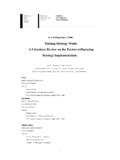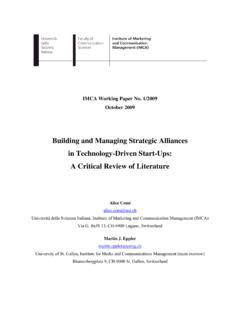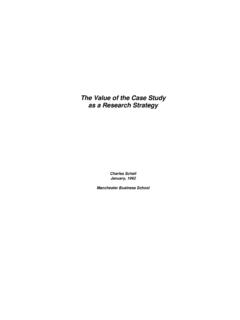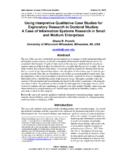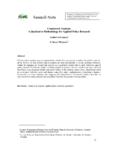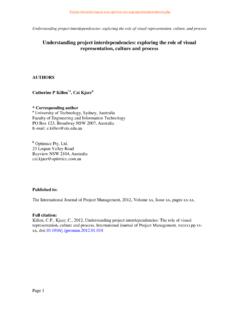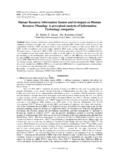Transcription of A Collaborative Dimensions Framework: …
1 Proceedings of the 41st Hawaii International Conference on System Sciences - 2008. A Collaborative Dimensions Framework: Understanding the Mediating Role of Conceptual Visualizations in Collaborative Knowledge Work Sabrina Bresciani,University of Lugano (USI), Switzerland, Alan F. Blackwell, University of Cambridge, UK, Martin Eppler, University of Lugano (USI), Switzerland, Abstract Facilitating Collaborative knowledge work paper, our goal is to identify the factors that is a crucial issue in management: knowledge is a contribute to the choice of an effective visual key corporate asset, but it is typically spread representation for Collaborative knowledge work across various people in different organizational to support distributed cognition, and to organize functions.
2 In this paper we explore how them in a conceptual framework. We focus on conceptual visualizations (such as diagrams, visualisation as an artefact, rather than on the visual metaphors, charts, sketches) can be people who use it. This technical focus allows us constructed and used as cognitive artefacts that to express important decision factors as support Collaborative knowledge work. In order Dimensions properties of a visualization that to facilitate tasks such as the creation and either facilitate or discourage certain kinds of sharing of knowledge in teams, we propose a use.
3 Often there are trade-offs between these Collaborative Dimensions framework as a tool for Dimensions , such that choosing a particular kind understanding how visual artefacts can facilitate of visualization will be beneficial for one collaboration in circumstances that involve purpose, while less useful, or even obstructive, distributed knowledge. The framework is based for another. on the widespread Cognitive Dimensions of Understanding these decision factors is Notation framework and is enriched with criteria particularly valuable for meeting leaders, from the boundary object paradigm discussed in consultants, and any person involved in organization science.
4 The Dimensions of the designing a meeting interaction, when they must framework are described and then applied to choose how to support Collaborative knowledge three different visualizations that are used in work with visual representations. Such Collaborative knowledge work. A discussion of understanding is also likely to be of value to future research needs concludes the paper. researchers and product developers who create novel visualisation support tools. In particular, it is beneficial for such 1. Introduction facilitators and tool developers to understand the existence of trade-offs between Dimensions .
5 This Business meetings are multimodal. is in contrast to the frequent advocacy of design Although much Collaborative knowledge work guidelines that are presented as universal consists of verbal exchanges, most meetings in attributes of a good visualisation. We show that organizational contexts also include shared and the best designs are likely to result from distributed visual representations. These range selecting a combination of Dimensions that are from simple ordered lists such as a meeting best suited to a particular type of Collaborative agenda, or bullet points on a presentation slide, activity, and that should therefore be prioritised to complex visualisations of conceptual relations, in that situation, rather than a checklist.
6 Strategic interactions, data charts or technical approach that focuses on satisfying an absolute designs. set of quality criteria. Thus far, there is little support beyond common sense guidelines for choosing which 2. Methodology visualisation might be most appropriate in any given context. Most such decisions are driven Our findings are derived firstly from the either by the capabilities of the tools to hand ( analysis of research literature on visualisation Power Point, Excel), or by the habits and and collaboration, and secondly from a preferences of a particular individual, combination of expert panels and exploratory professional community or organisation.
7 In this interviews with reflective practitioners who 1530-1605/08 $ 2008 IEEE 1. Proceedings of the 41st Hawaii International Conference on System Sciences - 2008. routinely employ visualisations in Collaborative choice might either encourage or discourage business contexts. The structure of the paper narrative presentation, or support reference to reflects these two sources, followed by the specific elements of a visualisation. presentation of a design framework that takes Research into the function of boundary both into account. objects focuses on knowledge transfer and its integration into organizational and design Literature review practice.
8 Star and Griesemer [17] considered the characteristics that boundary objects should have We focus on reviewing three main fields to be able to bridge knowledge across different that are particularly relevant to provide the organizational functions or divisions. Those theoretical foundation of this work: (i) the theories attracted the interest of a number of Cognitive Dimensions framework on notations, authors in different fields, including the work of especially as applied in the context of research Carlile [5] in management and of Ewenstein and on diagrammatic reasoning and design, (ii) Whyte [7] in architecture.
9 Their findings show research into the function of boundary objects, in that, through the use of boundary objects, people the context of organization science, and (iii) the from different areas of expertise can bridge their general scientific discourse on information and separate knowledge domains, create a shared knowledge visualization. understanding, and improve decision making. One starting point for this review is the Boundary object research shares the same Cognitive Dimensions of Notations framework, goal as the research that we propose here, originally proposed by Thomas Green [9].
10 As an however, analytic descriptions of visual applied cognitive psychologist who had spent boundary objects or ad-hoc creation of boundary many years investigating the usability properties object visualizations have thus far attracted of visual notations, Green discovered that it was limited attention - with a few exceptions, such as seldom possible to cite specific experimental the work of Gasson [8] on Soft Systems results offering direct guidance with respect to Methodology for eliciting implicit knowledge. the design of new notations. It would be possible The cognitive and communicative dimension to conduct experiments to test each proposed frameworks have not previously been applied to feature, but this would be far too expensive.
